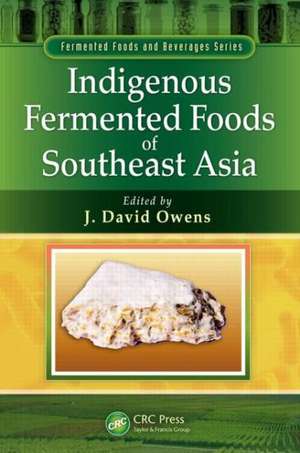Indigenous Fermented Foods of Southeast Asia: Fermented Foods and Beverages Series
Editat de J. David Owensen Limba Engleză Hardback – 10 dec 2014
Fermented foods and beverages span a range of root crops, cereals, pulses, vegetables, nuts, fruits, and animal products. Southeast Asia has a long history of utilizing fermentation in the production and preservation of foods, and is widely recognized for its prominent use. Indigenous Fermented Foods of Southeast Asia examines some indigenous fermented foods of Thailand, Vietnam, Indonesia, Malaysia, and the Philippines, focusing on the chemical, microbiological, and technological factors associated with their manufacture, quality, and safety. This text establishes a need for an adequate understanding of the fermentation process to ensure safe and reliable practices, as well as the consistent production of a quality product.
The authors describe the production, microbiology, biochemistry, nutritional value, and dietary roles of a wide variety of indigenous fermented foods of Southeast Asia. Emphasizing the microbiological and biochemical processes in fermentations and examining the factors that influence the development of the characteristic microflora and chemical changes induced, they accurately describe each process and critically evaluate the roles of microbes in the fermentation. The classification of products is based on their microbial ecology (i.e. the predominant microbes involved), and the text includes examples of every major category of fermented food. The book covers tempe, starter cultures, sweet/sour/alcoholic rice and cassava fermentations, alcoholic fermentations, soy sauce, Bacillus fermentations, and lactic acid bacterial fermentations of vegetables, durian fruit, rice noodles, meats, and sea foods.
This book answers a series of basic questions addressing:
- Dominant/desired microbes
- Suitable factors in processing and the environment
- Commonly present microbes
- Compounds utilized as major carbon and energy sources
- Sources of fermentable carbohydrates
- Main biochemical activities and chemical changes
- True yield of product per kilogram of initial raw materials
- Possible hazards associated with a product
- How possible hazards may be minimized or eliminated
- Research needs and opportunities
Preț: 1258.91 lei
Preț vechi: 1755.96 lei
-28% Nou
Puncte Express: 1888
Preț estimativ în valută:
240.90€ • 252.15$ • 200.50£
240.90€ • 252.15$ • 200.50£
Comandă specială
Livrare economică 10-24 martie
Doresc să fiu notificat când acest titlu va fi disponibil:
Se trimite...
Preluare comenzi: 021 569.72.76
Specificații
ISBN-13: 9781439844809
ISBN-10: 1439844801
Pagini: 453
Ilustrații: 138
Dimensiuni: 156 x 234 x 28 mm
Greutate: 1.65 kg
Ediția:1
Editura: CRC Press
Colecția CRC Press
Seria Fermented Foods and Beverages Series
Locul publicării:Boca Raton, United States
ISBN-10: 1439844801
Pagini: 453
Ilustrații: 138
Dimensiuni: 156 x 234 x 28 mm
Greutate: 1.65 kg
Ediția:1
Editura: CRC Press
Colecția CRC Press
Seria Fermented Foods and Beverages Series
Locul publicării:Boca Raton, United States
Cuprins
Tempe and Related Products. Starter Cultures. Sweet, Sour, Alcoholic Solid Substrate Fermentations. Wines. Lactic Vegetable and Fruit Fermentations. Lactic Fermented Rice Noodles. Lactic Fermentations of Fish and Fishery Products. Lactic Meat Fermentation. Soya Sauce. Bacillus Fermentations. Index.
Notă biografică
Dr. J. David Owens is currently an Honorary Fellow in the Department of Food and Nutritional Sciences, University of Reading, UK.
Descriere
This book describes the production, microbiology, biochemistry, nutritional value, and roles in the diet of indigenous fermented foods of Southeast Asia. It examines the factors that influence the development of the characteristic microfloras and the chemical changes induced. It classifies products based on microbial ecology rather than on substrate or region. Each chapter describes the product, its history, and place of production; characteristics of the microbes, substrate, and metabolism; safety considerations and potential for growth by bacterial pathogens; as well as identifying research needs.






